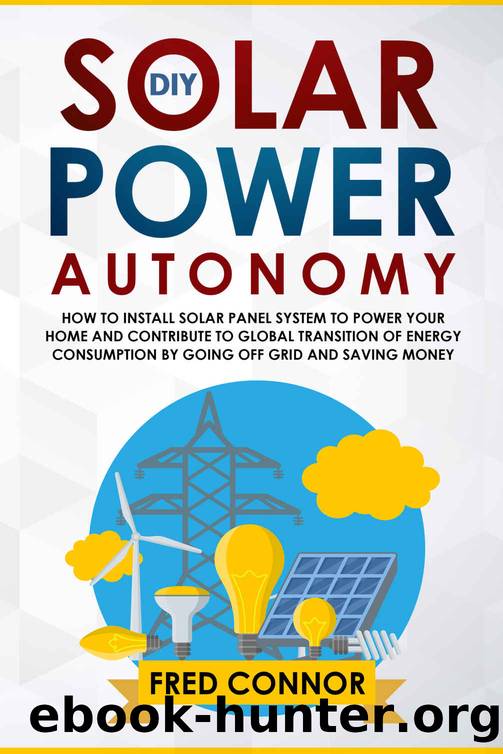DIY Solar Power Autonomy: How to Install Solar Panel System to Power your Home and Contribute to Global Transition of Energy Consumption by Going Off Grid and Saving Money (Ultimate Guide 2019) by Fred Connor

Author:Fred Connor [Connor, Fred]
Language: eng
Format: azw3
Published: 2019-04-16T00:00:00+00:00
So, we are ready to see the entire system in action. In order to do so, letâs suppose a rather large system that we are going to install.
First, we calculate our load and determined that we need around 500 watts. This would be enough to deal with the max load for all of the appliances contained in the home.
In order to obtain the 500 watts needed, we have determined to use two, 250-watt panels. We chose two panels as the configuration of the roof makes it ideal to use two panels. Plus, there isnât much space available elsewhere. So, two large panels make the most sense. Both panels are running on 24 volts. So, it is important to keep this in mind.
In order to make sure we donât run out of power, we have chosen to install three, 200-watt batteries. It is always best to go for a larger-capacity battery as having multiple, smaller batteries can be a nightmare to set up and to maintain. Also, it is a lot easier to replace one battery when it eventually requires replacing as opposed to replacing multiple batteries. Often, having multiple batteries leads to a guessing game in order to figure out which ones are not working properly.
Once you have selected the batteries, the next step is to figure our which charge controller you are going to use. I would go for an MPPT charge controller. Given the specs of the panels and the batteries, it would be ideal to choose a charge controller rated at 24 volts and 30 Amperes. In this example, we have an output of 500 watts divided by the 24 volts. This gives us an Ampere total of 20.83 Ah. So, it would be best to spring for a 30 Ampere controller. You could go for a 24 Ampere one if you donât want to have too much capacity.
Finally, the choice for this system would be a 1.5-kilowatt hour pure sine wave inverter. This capacity would allow the inverter to safely handle the load while managing the output from the batteries rather easily.
Download
This site does not store any files on its server. We only index and link to content provided by other sites. Please contact the content providers to delete copyright contents if any and email us, we'll remove relevant links or contents immediately.
| Automotive | Engineering |
| Transportation |
Whiskies Galore by Ian Buxton(41524)
Introduction to Aircraft Design (Cambridge Aerospace Series) by John P. Fielding(32882)
Small Unmanned Fixed-wing Aircraft Design by Andrew J. Keane Andras Sobester James P. Scanlan & András Sóbester & James P. Scanlan(32569)
Craft Beer for the Homebrewer by Michael Agnew(17927)
Turbulence by E. J. Noyes(7690)
The Complete Stick Figure Physics Tutorials by Allen Sarah(7135)
Kaplan MCAT General Chemistry Review by Kaplan(6587)
The Thirst by Nesbo Jo(6432)
Bad Blood by John Carreyrou(6270)
Modelling of Convective Heat and Mass Transfer in Rotating Flows by Igor V. Shevchuk(6219)
Learning SQL by Alan Beaulieu(6027)
Weapons of Math Destruction by Cathy O'Neil(5820)
Man-made Catastrophes and Risk Information Concealment by Dmitry Chernov & Didier Sornette(5641)
Digital Minimalism by Cal Newport;(5384)
Life 3.0: Being Human in the Age of Artificial Intelligence by Tegmark Max(5181)
iGen by Jean M. Twenge(5151)
Secrets of Antigravity Propulsion: Tesla, UFOs, and Classified Aerospace Technology by Ph.D. Paul A. Laviolette(4974)
Design of Trajectory Optimization Approach for Space Maneuver Vehicle Skip Entry Problems by Runqi Chai & Al Savvaris & Antonios Tsourdos & Senchun Chai(4837)
Electronic Devices & Circuits by Jacob Millman & Christos C. Halkias(4739)
